Coordinators:
Amar Ayyash (USA)
Mars Muusse (Netherlands)
thayers rings
thayers PDF's
thayers 1cy August
thayers 1cy September
thayers 1cy October
thayers 1cy November
thayers 1cy December
thayers 2cy January
thayers 2cy February
thayers 2cy March
thayers 2cy April
thayers 2cy May
thayers 2cy June
thayers 2cy July
thayers 2cy August
thayers 2cy September
thayers 2cy October
thayers 2cy November
thayers 2cy December
thayers 3cy January
thayers 3cy February
thayers 3cy March
thayers 3cy April
thayers 3cy May
thayers 3cy June
thayers 3cy July
thayers 3cy August
thayers 3cy September
thayers 3cy October
thayers 3cy November
thayers 3cy December
thayers sub-ad January
thayers sub-ad February
thayers sub-ad March
thayers sub-ad April
thayers sub-ad May
thayers sub-ad June
thayers sub-ad July
thayers sub-ad August
thayers sub-ad September
thayers sub-ad October
thayers sub-ad November
thayers sub-ad December
thayers ad January
thayers ad February
thayers ad March
thayers ad April
thayers ad May
thayers ad June
thayers ad July
thayers ad August
thayers ad September
thayers ad October
thayers ad November
thayers ad December
|
Thayer's Gull adult June
Below you will find a description of Chapter 36 THAYER'S GULL Larus thayeri, as published in one of the best Gull publication: "Gulls of the Americas" by Steve Howell & Jon Dunn.
"we" in the text below refers to the original authors. If any errors occur in this text, please let me know and mail to marsmuusseatgmaildotcom.
PART 1: IDENTIFICATION SUMMARY & TAXONOMY
PART 2: FIELD IDENTIFICATION SIMILAR SPECIES - ADULT
PART 3: FIELD IDENTIFICATION SIMILAR SPECIES - 1ST CYCLE
PART 4: FIELD IDENTIFICATION SIMILAR SPECIES - 2ND CYCLE
PART 5: RARER SPECIES
PART 6: DESCRIPTION AND MOLT - ADULT & 1ST CYCLE
PART 7: DESCRIPTION AND MOLT - 2ND & 3RD CYCLE
BELOW: PART 2
 |
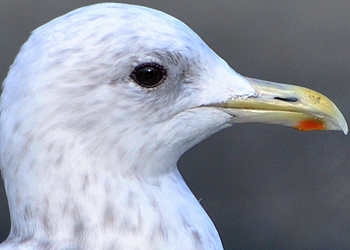 |
| Thayer's Gull "Cipriana" 1st cycle - adult, February 2008 - March 2013, Lago Fish farm - San Cibrao Harbour, Lugo, N Spain. |
Thayer's Gull adult, December 30 2011, Tukwila, WA. Picture: Amar Ayyash. |
 |
 |
| Thayer's Gull adult, January 02 2012, Ocean Shores, WA. Picture: Amar Ayyash. |
Thayer's Gull adult, January 02 2012, Ocean Shores, WA. Picture: Amar Ayyash. |
 |
 |
| Thayer's Gull (thayeri) adult, February 22 2008, Vancouver Island, BC (Guy Monty). Dark iris. |
Thayer's Gull (thayeri) sub-adult, February 11 2012, Pelagic off Lewes, DE (Adrian Hinkle).
Note thayeri pattern on P9-P10, no black on P5. |
FIELD IDENTIFICATION
SIMILAR SPECIES
Thayer’s Gull is medium-large, fairly long winged, and relatively slender billed, but its measurements overlap with most other large gulls, so identification should be based on a suite of characters. In particular, note overall size and structure (in comparison to gulls of known identity), especially bill size and shape, and wingtip pattern.
Adult Cycle.
The main confusion species is American Herring Gull, but also consider hybrids. Note overall size and structure, pale gray upperparts, slaty blackish wingtips (which often look simply black in the field, unless compared to truly black-winged species), pink legs.
 AMERICAN HERRING GULL (widespread) averages larger and, especially stouter billed; slightly paler gray upperparts (Kodak 4-5) rarely apparent in sunny conditions. Wingtip patterns can overlap with Thayer’s, but dark portions on Thayer’s wingtips are slaty blackish (Kodak 14.5-17), not jet black as on Herring (Kodak 18-19), and are largely restricted to the tips and outer webs - so underwingtip of Thayer’s looks mostly silvery gray with narrow dark trailing edge, not blackish as on most Herrings, especially those in the West. Thayer’s eyes are usually dirty yellowish to brown, rarely staring pale lemon, its orbital ring purplish pink, and its legs often brighter pink than Herring. On winter adults, the dusky head and neck markings of Thayer’s average more mottled, less streaked, and the bill rarely has distinct dark distal marks, which are often shown by Herrings. AMERICAN HERRING GULL (widespread) averages larger and, especially stouter billed; slightly paler gray upperparts (Kodak 4-5) rarely apparent in sunny conditions. Wingtip patterns can overlap with Thayer’s, but dark portions on Thayer’s wingtips are slaty blackish (Kodak 14.5-17), not jet black as on Herring (Kodak 18-19), and are largely restricted to the tips and outer webs - so underwingtip of Thayer’s looks mostly silvery gray with narrow dark trailing edge, not blackish as on most Herrings, especially those in the West. Thayer’s eyes are usually dirty yellowish to brown, rarely staring pale lemon, its orbital ring purplish pink, and its legs often brighter pink than Herring. On winter adults, the dusky head and neck markings of Thayer’s average more mottled, less streaked, and the bill rarely has distinct dark distal marks, which are often shown by Herrings. |
 |
 |
| American Herring Gull (smithsonianus) adult, October 28 2007, Monterey Bay, CA (Jeff Poklen). West coast bird in active moult: P10 old, active moult in rectrices. Lacking obvious immature markings, but little black in the greater primary coverts. Bold winter streaking. Complete W-pattern on P5 and black on P4. Note very short P10-tongue, on far wing from below. |
American Herring Gull (smithsonianus) adult, November 14 2004, Monterey Bay, CA (Jeff Poklen). This bird is most probably in adult plumage, as it lacks any immature markings in the greater primary coverts, tail, secondaries or tertials. Bold winter streaking and paler base of bill. Incomplete W-pattern on P5 and a tiny spot on P4. |
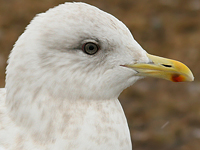 KUMLIEN’S GULL (ne. N. America) averages slightly smaller with shorter blunter-tipped bill, slightly shorter and blunter wing projection. Wingtip markings slaty gray (mainly Kodak 7-10) and often less extensive, upperparts slightly paler (Kodak 4-5). P10 rarely has dark subterminal marks, and P5 usually unmarked; P9 mirror usually crosses both webs and dark on medial portion of P9 rarely extends noticeably onto inner web. Presumed hybrids with Thayer’s look intermediate and are not safely assigned to either taxon. KUMLIEN’S GULL (ne. N. America) averages slightly smaller with shorter blunter-tipped bill, slightly shorter and blunter wing projection. Wingtip markings slaty gray (mainly Kodak 7-10) and often less extensive, upperparts slightly paler (Kodak 4-5). P10 rarely has dark subterminal marks, and P5 usually unmarked; P9 mirror usually crosses both webs and dark on medial portion of P9 rarely extends noticeably onto inner web. Presumed hybrids with Thayer’s look intermediate and are not safely assigned to either taxon. |
 |
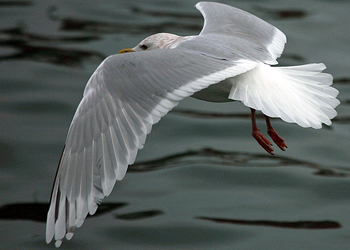 |
| Kumlien's Gull (kumlieni) adult, February 10 2007, Newfoundland (Chris Gibbins). Wingtip medium grey (Estimated Kodak 7-10). Wingtip pattern darker grey or more extensive grey marks on the outer five primaries with complete subterminal bands on zero to three primaries. |
Kumlien's Gull (kumlieni) adult, February 07 2007, Newfoundland (Chris Gibbins). Wingtip medium-dark grey (Estimated Kodak 11-13). Wingtip pattern darker grey or more extensive grey marks on the outer five primaries with complete subterminal bands on zero to three primaries. |
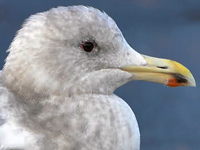 HYBRID GLAUCOUS-WINGED GULL X AMERICAN HERRING GULL (w. N. America) averages larger and bulkier with a bigger bill. Plumage and bare-part combinations can match Thayer’s, so attention to size and structure important. Hybrids often have broader wings with shorter wing projection (more like Glaucous-winged), orbital ring may show some yellowish (like Herring), and bill in winter often has dark distal marks (uncommon on Thayer’s; critical study needed of wingtip patterns. HYBRID GLAUCOUS-WINGED GULL X AMERICAN HERRING GULL (w. N. America) averages larger and bulkier with a bigger bill. Plumage and bare-part combinations can match Thayer’s, so attention to size and structure important. Hybrids often have broader wings with shorter wing projection (more like Glaucous-winged), orbital ring may show some yellowish (like Herring), and bill in winter often has dark distal marks (uncommon on Thayer’s; critical study needed of wingtip patterns. |
 |
 |
Glaucous-winged Gull x American Herring Gull adult, November 20 2011, Westmoreland Park, OR (Amar Ayyash). Pale eyed bird, with many traits of Glaucous-winged Gull. |
Glaucous-winged Gull x American Herring Gull adult, December 30 2011, Tukwila, WA (Amar Ayyash). Glaucous-winged is known for its hybrids with Western Gull (so-called Olympic Gulls), but there also seem to be no shortage of Glaucous-winged x Herring Gulls (so-called Cook Inlet Gulls). These Cook Inlet Gulls tend to show smaller bills than Olympic Gulls. |
 HYBRID GLAUCOUS-WINGED GULL X WESTERN GULL (w. N America) can suggest Thayer’s Gull in plumage but tends to be darker above (mostly Kodak 6-8) and bill notably stouter often with a swollen gonys; also note large overall size, broad wings, and relatively short wing projection. Hybrids rarely show extensive, neatly demarcated white on P9-P10. Behavior is also a clue: If you think you see a Thayer’s Gull dominating feeding Western and Glaucous-winged gulls, then it’s most likely a hybrid. HYBRID GLAUCOUS-WINGED GULL X WESTERN GULL (w. N America) can suggest Thayer’s Gull in plumage but tends to be darker above (mostly Kodak 6-8) and bill notably stouter often with a swollen gonys; also note large overall size, broad wings, and relatively short wing projection. Hybrids rarely show extensive, neatly demarcated white on P9-P10. Behavior is also a clue: If you think you see a Thayer’s Gull dominating feeding Western and Glaucous-winged gulls, then it’s most likely a hybrid. |
 |
 |
| Olympic Gull glaucescens x occidentalis adult, February 16 2009, Portland, Oregon (Lyn Topinka). Purple orbital ring and extensive speckling in iris ( >75%). Medium grey primary pigmentation, obviously darker than upperparts indication for occidentalis influences. |
Olympic Gull occidentalis x glaucescens adult, December 03 2008, Vancouver Island, BC (Guy Monty). Pigmentation on primaries intermediate, and grey tone upperparts intermediate. |
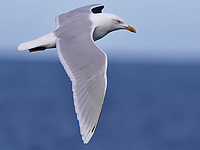 HYBRID GLAUCOUS GULL X AMERICAN HERRING GULL (widespread) larger with longer and stouter bill, paler gray upperparts, pale eyes, and orange orbital ring (can be pinkish in winter). Wingtip pattern might resemble Thayer’s but range of variation poorly known; should be separable by size and structure, especially bill. HYBRID GLAUCOUS GULL X AMERICAN HERRING GULL (widespread) larger with longer and stouter bill, paler gray upperparts, pale eyes, and orange orbital ring (can be pinkish in winter). Wingtip pattern might resemble Thayer’s but range of variation poorly known; should be separable by size and structure, especially bill. |
 |
 |
| Nelson's Gull hyperboreus x smithsonianus adult, May 23 2009, Palmer Landfill (Kirk Zufelt). Like a stalky Herring Gull. The white yellow eye and orange orbital ring is typical for Herring Gull. The primaries are an odd greyish-black. |
Nelson's Gull hyperboreus x smithsonianus adult, January 03 2010, Superior Landfill, MI (Karl Bardon). Overall size, mantle color, eye color, bill shape, etc. are clearly that of a Glaucous Gull but the gray markings on the dorsal outer primaries are a clear indication of hybridization. Note the similarity in these markings to a Kumlien's Iceland Gull. |
 VEGA GULL (w. Alaska), larger and bulkier with stouter bill, upperparts slightly darker (Kodak 7-8), more extensive black wingtip contrasts below, orbital ring reddish. VEGA GULL (w. Alaska), larger and bulkier with stouter bill, upperparts slightly darker (Kodak 7-8), more extensive black wingtip contrasts below, orbital ring reddish. |
 |
 |
| Vega Gull (vegae) adult, December 2009 - January 2010, Choshi, Japan (Chris Gibbins). Dark iris, dark grey upperparts (Kodak 7-8), late moult (P8 fully grown, P9-P10 growing), and pink legs. Note purplish orbital ring. |
Vega Gull (vegae) adult, December 2009 - January 2010, Choshi, Japan (Chris Gibbins). Dark iris, heavily streaked head continuing on upper breast, dark grey upperparts. |
 GLAUCOUS-WINGED GULL (w. N. America) averages larger with proportionately shorter and broader wings, relatively shorter wing projection, and stouter bill. Thayer’s typically has slaty blackish wingtips quite different from Glaucous-winged, but some birds (hybrid Thayer’s x Kumlien’s?) have charcoal gray wingtips similar to dark or hybrid (Glaueous-winged Gulls. Best separated by structure. GLAUCOUS-WINGED GULL (w. N. America) averages larger with proportionately shorter and broader wings, relatively shorter wing projection, and stouter bill. Thayer’s typically has slaty blackish wingtips quite different from Glaucous-winged, but some birds (hybrid Thayer’s x Kumlien’s?) have charcoal gray wingtips similar to dark or hybrid (Glaueous-winged Gulls. Best separated by structure. |
 |
 |
| Glaucous-winged Gull glaucescens adult, March 22 2009, Malibu, CA (Hart Walter). Note really pale gray pigmentation on outer primaries and dark iris. |
Glaucous-winged Gull glaucescens adult, March 24 2007, Newport, OR (Greg Gillson). Purple orbital ring and extensive speckling in iris ( >75%). Primary tips are a shade darker than upperparts, medium grey (about Kodak 7). |
|
 Thayer's adult, June 02 2009, Churchill, Manitoba, Canada. Picture: Tom Johnson. Thayer's adult, June 02 2009, Churchill, Manitoba, Canada. Picture: Tom Johnson. |
 Thayer's Gull (thayeri)
Thayer's Gull (thayeri) Thayer's adult, June 02 2009, Churchill, Manitoba, Canada. Picture: Tom Johnson.
Thayer's adult, June 02 2009, Churchill, Manitoba, Canada. Picture: Tom Johnson. Thayer's adult, June 02 2009, Churchill, Manitoba, Canada. Picture: Tom Johnson.
Thayer's adult, June 02 2009, Churchill, Manitoba, Canada. Picture: Tom Johnson. Thayer's adult, June 07 2009, Churchill, Manitoba, Canada. Picture: Tom Johnson.
Thayer's adult, June 07 2009, Churchill, Manitoba, Canada. Picture: Tom Johnson. Thayer's adult, June 04 2009, Churchill, Manitoba, Canada. Picture: Tom Johnson.
Thayer's adult, June 04 2009, Churchill, Manitoba, Canada. Picture: Tom Johnson. Thayer's adult, June 02 2009, Churchill, Manitoba, Canada. Picture: Tom Johnson.
Thayer's adult, June 02 2009, Churchill, Manitoba, Canada. Picture: Tom Johnson. Thayer's / Kumlien's Gull adult, June 07 2009, Churchill, Manitoba, Canada. Picture: Tom Johnson.
Thayer's / Kumlien's Gull adult, June 07 2009, Churchill, Manitoba, Canada. Picture: Tom Johnson. Distribution of Thayer's Gull. Breeding areas, migration routes and wintering areas. FROM: "Gulls of the Americas" by Steve Howell & Jon Dunn.
Distribution of Thayer's Gull. Breeding areas, migration routes and wintering areas. FROM: "Gulls of the Americas" by Steve Howell & Jon Dunn. Distribution of Kumlien's Gull. Breeding areas, migration routes and wintering areas. FROM: "Gulls of the Americas" by Steve Howell & Jon Dunn.
Distribution of Kumlien's Gull. Breeding areas, migration routes and wintering areas. FROM: "Gulls of the Americas" by Steve Howell & Jon Dunn. Distribution of hybrid gull taxa in Gull. Selected zones of hybridisation in the nortrh Pacific / Bering Sea region. FROM: "Gulls of the Americas" by Steve Howell & Jon Dunn.
Distribution of hybrid gull taxa in Gull. Selected zones of hybridisation in the nortrh Pacific / Bering Sea region. FROM: "Gulls of the Americas" by Steve Howell & Jon Dunn.
























